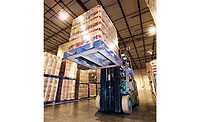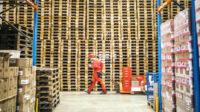Reducing impact through reusable assets
Suppliers seek durable and detectable containers

With a portfolio of pallets individually embedded with radio-frequency identification chips, iGPS offers trackable shipments.

Orbis Corp. developed the returnable, collapsible high-density MaxCube bulk container for plastic pre-forms, caps and closures markets.

Rehrig Pacific developed the EZ Pal & Lift System that includes a half-pallet, electric lift and dolly and was designed to allow faster deliveries to small-format stores.



Beverage-makers employ a variety of methods to get their products from the manufacturer or distributor into the retailers. But an otherwise smooth cycle can reach a speed bump when companies look for solutions that create less waste than one-way disposable delivery options. Attempting to close the loop are a plethora of reusable and returnable assets including pallets, delivery systems, kegs and intermediate bulk containers (IBCs).
“First and foremost is probably the environmental and sustainability benefits,” says Rex Lowe, president of iGPS Co. LLC, Orlando, Fla. “Reusable packaging, if properly managed, really takes a lot of waste out of the system and, therefore, the environment in that you’re reducing significantly the amount of packaging material that’s involved in transporting product. You’re also reducing significantly the amount of throw-away and the problems that are being created in the landfills where one-way packaging is disposed.”
Rehrig Pacific Co., Los Angeles, designs and manufactures reusable packaging systems that vary from primary to tertiary solutions across a variety of industries. It recently introduced its fifth-generation family of reusable containers for transporting and displaying 2-liter, 1-liter, 32-ounce, 20-ounce, 500-ml. and 12.5-ounce beverages. The products provide a lower cost and smaller carbon footprint for each trip and are customizable for increased brand building and flexible displays at retail, explains Trent Overholt, vice president of supply chain solutions for the company. Overholt says some of its customers merchandise products in the colorful and custom-designed Rehrig Pacific containers, which also include pallets.
“In terms of how we approach our customers, we try to come in more broadly and look for ways that a reusable system can drive supply-chain efficiencies and have a positive impact on sustainability and sales,” Overholt explains.
For beverage-makers looking to track their products, the company has a team that is dedicated to embedding reusable systems with technology, including radio-frequency identification (RFID) tags and temperature-tracking devices, he says.
Pool party
Operating a pallet pool of containers, iGPS manages the quantity and quality of container platforms used by its customers, Lowe says. The company is responsible for delivering the assets to the manufacturer that then uses the containers to transport its products to the retailer after which the pallet pool collects, cleans and refurbishes the assets. For tracking throughout the supply chain, iGPS’ pallets each have an individually identified and sequenced RFID chip. Technology advancements also have led to new features, including temperature tracing for sensitive products, shock monitoring during shipment and the ability to combine the unit load’s information with the serial number of the pallet to track the entire load, Lowe explains.
A subsidiary of Sydney-based Brambles Ltd., Chep USA, Orlando, Fla., also offers pallet pool services. To demonstrate the sustainable benefits of its business, Chep had its environmental impact evaluated by a third party, explains Michael Pooley, senior vice president for the company.
“The energy savings from our business in 2011 alone, when compared to one-way disposable pallets, is enough to power every household in Tampa and Orlando, Fla., combined for an entire year,” he says.
In addition to developments designed to accommodate lightweight packaging on its pallets and return-trip efficiency, Chep maintains an innovation center in Orlando, Fla., where it tests the effects of distribution on its pallets and customer loads. Chep has sister companies that provide IBCs as well as returnable container and pallet management solutions, it notes.
With rising transportation costs, Orbis Corp., Oconomowoc, Wis., is seeing more customers requesting returnable containers and pallets that offer load optimization, explains Pat Huesing, the company’s vice president of beverage sales. In addition to optimizing outbound shipments and shipping more product on each truck, customers are seeking to load more empty containers on trucks during return trips, he explains.
Orbis’ operations permeate throughout the beverage supply chain, and the company also runs two service subsidiaries: Corbi Plastics and Orbis Reusable Packaging Management (RPM). Corbi Plastics started in 2005 and is dedicated to the ownership, management and return of the pallets, top frames and slip sheets for one of Orbis’ largest customers, Huesing says. In contrast, Orbis RPM customers own the assets and Orbis RPM manages them, he notes.
Focused on brewery assets, Houston-based Satellite Logistics Group’s (SLG) Kegspediter system was designed to facilitate more frequent return of kegs to breweries, says Kevin D. Brady, president and chief executive officer of SLG. The system uses sales forecasts or historical data to facilitate the collection and return of empty kegs from distributors, he says.
One noteworthy trend, Brady notes, is that individual keg scanning has begun to emerge. Although an industry-wide uniform method for scanning kegs has yet to be adopted, he says that for early adopters, individual keg scanning has enabled distributors to receive their keg deposits faster and in the future could pinpoint the exact location of kegs throughout the supply chain.
Loss prevention
Due to the valuable material that comprises many reusable containers, theft and reselling to unauthorized parties are industry-wide concerns.
Rehrig Pacific manufactures its pallets and containers from a high-quality and higher-grade polyolefin plastic, which ensures that Rehrig Pacific’s products will perform as guaranteed and that they sustain a higher residual value, Overholt says. The company also has developed tracking methods and partnerships with local authorities when theft occurs. He explains that Rehrig Pacific has found that 80 percent of product loss can often be tracked to 5 percent of a company’s customers. In those channels, the company can add global positioning system (GPS) tags to containers and send those into a problematic account for tracking.
With a portfolio of pallets that are individually tagged with RFID devices, iGPS also is able to track pallets in an effort to locate lost items. In combination with the RFID chips, Lowe explains that GPS devices are embedded into some of its pallets for load location. It also maintains relationships with industry coalitions as well as offers a bounty for its pallets to make them less valuable to resellers, Lowe explains.
System solutions
Suppliers also are engineering assets in response to customer requests and industry demands. South African company Lomold designed its Lomold Pallet System, the base of which includes two size options of Lomold Nesting Pallets that are made from long-glass fiber reinforced plastic, explains Niels Martin, president of Lomold USA LLC. The company offers a variety of accessories for the system including bottom decks, edge-lips, wheels, extensions, RFID chips and tracking systems. Lomold’s Nesting Pallets weigh 35 pounds for a full racking pallet and can reduce shipping costs by as much as 75 percent compared to standard pallets, Martin says. In addition, Lomold offers pallet management services, lease arrangements and closed-loop pools, he explains.
Due to its material, Lomold’s assets will damage traditional regrind equipment and therefore are less desirable to unauthorized resellers, he notes. However, the company provides its own pallet recycling program in which the company will re-purchase Lomold pallets and recycle them into new products.
Based on customer feedback, Rehrig Pacific developed its EZ Pal & Lift System, which is a proprietary reusable half-pallet, electric lift and dolly designed to allow a customer’s small-format route drivers to get in and out of a store more quickly, Overholt explains. The EZ Pal & Lift System also allows the customer to deliver from a rear-loading truck instead of a side bay, he adds. The company’s solution is available to all direct-store delivery customers and Rehrig Pacific also is targeting breweries and wholesalers with a similar Pallet & Lift System adapted for half- and sixth-barrel kegs.
Another innovation is Rehrig Pacific’s PubKeg, a primary package that is the size of a sixth-barrel keg with a replaceable PET bottle and a reusable outer shell and lid. The interior bottle is sanitized and has a ready-to-fill valve for a variety of liquids, ranging from beer to wine, Overholt says.
Pre-packaging assets
When it comes to shipping ingredients or packaging materials, collapsible bulk containers offer reusable options. Orbis Corp. developed the returnable, collapsible high-density MaxCube bulk container for plastic pre-forms, caps and closures markets, Huesing says. The design also addresses back-haul concerns, says Chris Shepard, the company’s product manager for beverages.
“Looking at the return portion, nobody likes to ship air,” Shepard says. “So when returning the MaxCube for replenishment, it collapses down to only 13 inches, so the density of the load going back to the pre-form manufacturer gets as many bins on [the truck] as possible so that they can fill it back up and move more product.”
Grayling Industries Inc., Alpharetta, Ga., provides multi-ply liners for intermediate bulk packaging such as flexible intermediate bulk containers and totes. Many of its products are made from high-density polyethylene, which can be recycled, explains Raymond Joyner, director of sales for Grayling Industries. The company maintains a close relationship with Buckhorn, Milford, Ohio, to provide solutions for its IBCs, explains Raymond Joyner, director of sales for Grayling Industries.
Most recently, Grayling Industries developed a pressure-dispense liner system that was designed for products that are highly viscous. The system has bladders that fill with air as the product dispenses and helps ensure more of the product leaves the liner, Joyner says. BI
Looking for a reprint of this article?
From high-res PDFs to custom plaques, order your copy today!









